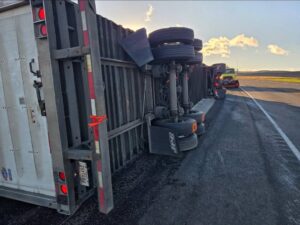“A lack of truck parking across the country is about more than just inconvenience, it impacts safety and retention as exhausted drivers have nowhere to rest.” — The White House
WASHINGTON — From acknowledging the lack of safe 18-wheeler parking to ensuring female truck drivers are safe from sexual predators, President Joe Biden and members of his administration on Monday, April 4, addressed multiple key issues facing the trucking industry as part of an update on his Trucking Action Plan (TAP).
“I want to thank you … (for) keeping America moving, because that’s literally what you’re doing — especially these last two years, helping carry the nation literally on your backs,” Biden said.
“All of you here today are people our economy should be built around, because you all, you all are the people who literally make it run,” Biden told truckers in the audience. “That’s not hyperbole. You literally make it run. I have nothing against investment bankers. They could all retire and nothing much would change. Y’all quit? Everything comes to a halt.”
The TAP was launched by the U.S. Department of Transportation (DOT) and U.S. Department of Labor (DOL) last December to, as the White House frames it, “increase the supply of truck drivers by creating new pathways into the profession, cut red tape to expand high quality training … and lay the foundation for improving job quality to keep people in the profession.”
During the White House news conference on Monday, DOT Secretary Pete Buttigieg called trucking “a national priority,” adding that “truck drivers bring us the things we need.”
“If you enjoyed the food you ate for breakfast, the clothes you are wearing or device you are using to watch this, you can thank a truck driver for getting this to you,” he said. “That is what makes this TAP so important.”
According to the White House, when Biden took office, there were 30,000 fewer trucking jobs than in February 2020, and trucking employment had been falling even before that.
“But last year’s job growth across the economy resulted in 2021 registering as the best year for trucking job growth since 1994,” according to a White House statement.
Trucking employment now exceeds its pre-pandemic level by 35,000 and is higher than it was before it began to decline in 2019, the White House says.
Still, organizations such as the American Trucking Associations (ATA) estimate that there is still a shortage of roughly 80,000 truck drivers nationwide.
Trucking employment growth over the last year was strongest in California, where it exceeded 10%, as well as in Missouri, New Jersey, Ohio and Washington, where it exceeded 8%, according to the White House.
“Long-distance truck driving has been the sector of trucking facing the most challenges, but we are now seeing fresh momentum there: December through February was the best three-month stretch for long-distancing trucking employment growth since the 1990s (data are currently only available through February),” the White House statement read.
DOT has worked with states and governors to accelerate commercial driver’s license (CDL) processing, and the DOT just announced that more than $57 million in funding is available to help states expedite CDLs, coordinate waivers and provide all 50 states a toolkit detailing specific actions to expedite licensing, along with working hand-in-hand with states to address challenges.
The White House said the result has been a 112% increase in CDL processing in January and February 2022 compared to January and February 2021.
States have issued more than 876,000 CDLs since January 2021, according to the White House.
As part of the 90 Day Trucking Apprenticeship Challenge, which was designed to help jump start the new trucking jobs, more than 100 employers across trucking, food and grocery, and the oil and gas industries launched Registered Apprenticeship programs in 90 days, the White House said.
This includes Domino’s, Frito-Lay, UPS, states and national partners such as FASTPORT and the International Brotherhood of the Teamsters.
“This proven earn and learn model of workforce training will help employers and labor develop and retain a skilled workforce,” according to the White House.
“Apprentices are already hitting the road with NFI and Total Transportation, each hiring over 50 apprentices after launching new programs under the Apprenticeship Challenge.”
The White House said that “with these 100 employers and seven trade associations now offering apprenticeships, we have nearly doubled the number of programs nationwide. This could, in turn, double the number of registered apprenticeships in 2022 and result in more than 10,000 new registered apprenticeships. As a point of comparison, annual trucking employment growth averaged 24,000 in the decade before the pandemic.”
The White House said that more than 70 additional employers of all sizes and industry segments, including Sysco and WM (Waste Management Inc.), are in the process of developing and launching apprenticeship programs.
At Monday’s White House event, new truck driver Maria Rodriguez, who was aided by the Registered Apprenticeship Program, spoke about her life and how she became a trucker.
“My family came to this country when I was 10 years old from Venezuela,” she said. “We came looking for a better life and the American dream.”
Rodriguez, who has a background in the food service industry, said her father was a chef; however, she wanted to become an EMT or a firefighter. But she quickly found out that the training hours kept her away from home and her son too often.
After the worst of the COVID-19 pandemic was over, she said she began wondering what to do next. Living just a few miles from a truck training school, she decided to go there and make the most of a new career. She said she found a home behind the wheel of an 18-wheeler.
“I was intimidated at first but immediately felt better because the company was so helpful,” said Rodriguez, who drives for NFI. “I love my schedule and get home before my son finishes school. I hope I can be an encouragement to other women thinking of joining the trucking industry.”
David Pike, director of recruiting for NFI, attended Monday’s event and said that success stories like Rodriguez’s are important to tell because they humanize the trucking industry.
“These are reputable and honorable jobs,” Pike said. “And this is the first time we can honestly say that drivers are making good wages. It’s a hard job, but at the end of the day, if you are not afraid to work hard, you can make an honest day’s pay and be compensated well.”
Pike said the recognition that the Biden administration is giving the trucking industry through the TAP “means more than anything in the world. (It is) bringing to light the importance of what we do as an industry regardless of the brand on side of our truck. It’s the fact that we keep this country moving.”
Pike said that the industry must also use the TAP to help bring back those who left trucking because of bad first experiences.
“We need to go back and attract them to the industry again,” he said. “And we hope we can see even more significant wages given back to the driver. The American public must be willing to pay more (for goods) to compensate the hard working men and women who run these roads daily.”
The White House said Monday that the Biden administration is also working with Veterans Service Organizations and related associations representing more than 4 million veterans and military family members to create ways for the trucking industry to attract, train, place and retain veterans in trucking jobs.
“This builds on the already strong connection between veterans and trucking as at least one in ten truckers are veterans, which is double the rate of workers overall,” according to the White House.
As for women in trucking, the White House said that it is expanding opportunities, including by creating safe and inclusive work environments.
“The Biden Trucking Action Plan remains a mixed bag of policies intended to improve jobs and employment opportunities within the industry. — Owner-Operator Independent Drivers Association
The Women of Trucking Advisory Board will review and report on challenges facing woman drivers and those interested in joining the profession, such as on-the-job safety risks, mentorship, quality training and opportunities for advancement.
DOT has begun soliciting nominations for the board.
The Biden administration also announced on Monday a Day of Action in April, coinciding with Sexual Assault Awareness and Prevention Month, to raise awareness and advocate for the prevention of sexual assault and sexual harassment in trucking.
“We will call on industry to commit to actions to promote safe training and work environments including zero-tolerance policies for sexual assault, improving sexual harassment training and more,” according to the White House.
The White House said that the administration is taking steps to ensure drivers entering the trucking industry “have a safe environment.”
DOT is now highlighting whistleblower and coercion protections for individuals facing sexual harassment and unsafe training conditions in its Entry Level Driver Training Program FAQ, which will be distributed to the 11,000 training providers, according to the White House.
DOL is also identifying employers in the trucking industry that have built supportive and inclusive workplaces for women and developing a “train the trainer” module for new Registered Apprenticeships sponsors who would receive a “seal of approval” upon completion to indicate training programs follow model gender-responsive training standards, the White House said.
Additionally, the White House said that the DOT, DOL and the Consumer Financial Protection Bureau (CFPB) are setting up a Truck Leasing Task Force to address predatory truck leasing arrangements and identify actions that could make leases more equitable and transparent.
The Task Force will review and report on common leasing arrangements, arrangements that result in outsize and unanticipated debt for incoming drivers and more.
On the issue of truck parking, the White House stated that “a lack of truck parking across the country is about more than just inconvenience, it impacts safety and retention as exhausted drivers have nowhere to rest.”
According to the White House, the Bipartisan Infrastructure Law (BIL) provides funding in at least five programs that states can use to address truck parking while requiring states to include an analysis of truck parking needs in their state freight plans, “laying the foundation to understand local needs.”

The Teamsters Union is applauding the TAP, saying that during the past 90 days, the administration has made substantial progress towards addressing critical issues for drivers and those interested in a career behind the wheel.
“The Biden administration is doing a good job at addressing our concerns,” said Sean O’Brien, Teamsters general president. “If companies want to fill openings, they need to pay well and provide good benefits, treat their workers with respect and make sure they are well trained.”
Just last month, three Teamsters who drive as part of their jobs told Biden officials about the advantages of union membership and the challenges they faced in organizing during an online listening session to discuss strategies for improving trucking job quality, and for retaining and recruiting drivers.
The Owner-Operator Independent Drivers Association (OOIDA) offered a more reserved statement on the TAP.
“The Biden Trucking Action Plan remains a mixed bag of policies intended to improve jobs and employment opportunities within the industry,” the statement read.
“We applaud the administration for adding truck parking to the plan and agree that the lack of parking across the country is about more than just inconvenience. OOIDA is also pleased that DOT along with other federal agencies has started gathering information on critical issues like detention time and driver compensation. However, drivers are still waiting on meaningful measures that will help address these problems. Today’s update notes significant progress on establishing apprenticeship programs and plenty of funding to help states expedite CDLs , but we have yet to really see any substantive actions that can help keep new or current drivers in the industry long-term.”
American Trucking Associations (ATA) President Chris Spear said that investing in the freight workforce should never stop.
“It’s a constant,” he said in a statement. “Our industry needs an additional 80,000 commercial truck drivers if we’re to meet consumer demand. We welcome the support of all elected officials as we recruit and train more talent into this critical industry. Recognizing our dedication to training and safety, the Departments of Labor and Transportation have worked quickly and efficiently in approving ATA as a registered apprenticeship sponsor. This long-sought designation provides our member companies valuable new tools and resources to help recruit and train the next generation of trucking talent. We thank and commend President Biden, Secretary Walsh, and Secretary Buttigieg for their commitment to the men and women of trucking who keep America moving forward.”
At the end of the event, Alphonso Lewis, an America’s Road Team Captain and U.S. Army veteran with nearly 30 years of experience as a professional truck driver for the Yellow Corp., gave Biden a tour of the inside of a truck cab while speaking about the opportunities that exist for veterans in trucking.
“Our nation’s heroes will find that America’s trucking industry is one big family with arms wide open,” Lewis said. “It was in the Army where I was trained and learned how to drive trucks, and it’s in this industry where I found my professional home after leaving the military. For any vet seeking a stable career path with good pay and benefits, I encourage you to look into the many opportunities that our industry has to offer.”
Born in Pine Bluff, Arkansas, and raised in East Texas, John Worthen returned to his home state to attend college in 1998 and decided to make his life in The Natural State. Worthen is a 20-year veteran of the journalism industry and has covered just about every topic there is. He has a passion for writing and telling stories. He has worked as a beat reporter and bureau chief for a statewide newspaper and as managing editor of a regional newspaper in Arkansas. Additionally, Worthen has been a prolific freelance journalist for two decades, and has been published in several travel magazines and on travel websites.
















No body has considered drivers who can’t get work because their insurance won’t insure drivers over 72 ive been driving for thirty years and have no chargeable accidents and no tickets in 10years when I apply the companies fight over me until they run there insurance and they tell me it’s because insurance companies think your to old to drive i have never failed a physical in my life there are a lot of drivers in the same situation
The article primary headline was LACK OF PARKING. And just like a politician the article glanced at the problem with saying females fear for their safety and BAM, No more mention or solution to parking. Employment and truck driver shortages are always going to be an issue. The job is made more difficult bc of parking and safe havens to rest. Accommodate this issue and you might get more truckers to sign on again. All the other issues are re-hashed jargon. Has no impact on the hiring.
for the past 3 years i have been under so much stress driving, due to the fact that i could have contracted covid many times and came home and gave it to my wife, simply because i was delivering to hospitals, picking up medical waste and other things. i thought we were going to get a bonus of some type for all of our valor, and we received nothing. im still driving because my family must eat and live, but my question is, what happened?
Check the guy standing in front of the truck – his head looks like he laid his head down on the toaster for a nap. jus’sayin’. There’s a story there, I’m not trying to be mean, just curious.
Blah Blah Blah… just “staging” love for truckers to shut us up!! The best years were under the Trump economy. I really don’t trust the things they say in this article as being genuine to slow joes admin….I think he plagiarized again, and they have hijacked it as “their plan”. It’s all pretty words!
Every aspect discussed on this article has a relevant importance, but I would like to see more articles and investigation reporters writing about how the cargo brokers seems to be manipulating rates for their own benefit . After checking with a couple of shippers, they have been hit with constant increase on transportation rates (that they have to transfer to consumers) but the carriers do not see any of these increases, even worse is that while fuel prices are rocketing high rates are going down….so Mr. President, would you consider this “encouraging” to the owners-operators? ….let me hear your comments about this topic.
Every aspect discussed on this article has a relevant importance, but I would like to see more articles and investigation reporters writing about how the cargo brokers seems to be manipulating rates for their own benefit . After checking with a couple of shippers, they have been hit with constant increase on transportation rates (that they have to transfer to consumers) but the carriers do not see any of these increases, even worse is that while fuel prices are rocketing high rates are going down….so Mr. President, would you consider this “encouraging” to the owners-operators? ….let me hear your comments about this topic.